Evolutionary Game and Simulation Analysis of Food Safety Regulation under Time Delay Effect
Abstract
:1. Introduction
2. Literature Review
- Integrating consumer feedback and government reward and punishment systems, this paper constructs a tripartite game model involving food enterprise, food inspection agency, and government regulatory. By employing ordinary differential equations and delay differential equations, it analyzes the strategy stability of each game participant and verifies the effectiveness and consistency of the model analysis under different initial conditions.
- Combining government reward and punishment mechanisms with consumer feedback, this study investigates the influence of different mechanisms on the strategic choices of food enterprise, food inspection agency, and government regulatory, as well as the impact of each element on the rate of evolution.
- Taking into account the strategic choices of food enterprise, food inspection agency, and government regulatory, which include cross-delay and self-feedback delays, this study uses numerical analysis and simulation to explore how delay terms and self-feedback intensity affect the strategic choices of each entity and their interactions. It focuses on analyzing how internal feedback mechanisms in the system lead to adjustments in strategy decisions and how such strategic adaptive adjustments impact the system’s long-term dynamics and stability.
| Feature | Ordinary Differential Equations (ODEs) | Delay Differential Equations (DDEs) |
|---|---|---|
| Definition | Equations that describe the relationship between one or more variables and their derivatives, assuming these relationships occur instantaneously. | In addition to the relationships between variables and their current derivatives, it considers the impact of the variable values at a past moment on the current state, introducing the concept of time delay. |
| Research Gap | - Unable to effectively handle or reflect the delay effects between decision making and implementation. - Ignores the impact of historical data on current decisions. | - Capable of simulating the delay between decisions and outcomes, more in line with real situations. - Considers the influence of historical states on current decisions and strategy changes, providing a more comprehensive analytical framework. |
| Limitations | Oversimplify actual problems when ignoring time delays. | More complex in terms of computation. |
3. Model Establishment and Assumptions
4. Model Analysis
4.1. Analysis of the Strategic Stability of Food Enterprise
4.2. Analysis of the Strategic Stability of Food Inspection Agency
4.3. Analysis of the Strategic Stability of Government Regulatory
4.4. Stability Analysis of Equilibrium Points in a Tripartite Evolutionary Game System
5. Numerical Analysis and Simulation
5.1. Numerical Analysis of Cross-Delay Parameter
- Government regulatory departments can utilize advanced information technology and big data analytics to monitor the production, circulation, and sales of food enterprises in real time, promptly identifying potential risks and non-compliant behaviors.
- Enhance the information sharing and coordinated cooperation among various regulatory departments within the government as well as between the government and food enterprises, consumers, to form a pattern of joint regulatory oversight.
- Develop and improve a rapid response mechanism for food safety issues, ensuring that once risks or non-compliance are detected, measures can be quickly taken to minimize losses and impact.
5.2. Numerical Analysis of Self-Feedback Delay Parameter
- Establish a blacklist system for enterprises that have violated regulations multiple times, listing them on the blacklist and making it public as a warning.
- Encourage the participation of food industry associations, professional institutions, and other third parties in food safety supervision. Utilizing their expertise and technical means, they can provide support and supplementation for government regulation, reducing the impact of time lag effects.
5.3. Simulation Analysis
- The government can motivate enterprises to produce and sell compliant products by offering tax reductions, subsidies, and preferential procurement policies.
- Encourage food companies to adopt new technologies to improve product quality and supply chain management, while also establishing industry cooperation platforms to facilitate information exchange and technology sharing among supply chain segments.
- The government can establish a digital supervision platform that utilizes big data and artificial intelligence for segmented assessment and prediction, in order to optimize the allocation of regulatory resources.
- Higher-level governments can encourage grassroots governments to cooperate in cross-regional regulation, implementing joint supervision of food enterprises operating across regions.
- Implement a government performance evaluation system to measure the performance of government departments at all levels based on specific indicators.
- The government can enhance public awareness of food safety and food inspection through education and promotional activities, thereby strengthening consumers’ self-protection abilities.
- It is also possible to provide consumers with convenient channels for easily reporting issues related to food quality and safety, such as setting up online platforms and hotline services.
- The government can implement differentiated reward and punishment plans, designing specific schemes for enterprises of different sizes and types, to achieve the rationalization of resource allocation.
- It is also possible to establish clear and quantifiable reward and punishment standards, rewarding or punishing enterprises and inspection agencies based on their performance, to achieve the fair distribution of resources.
6. Main Conclusions and Implication
- The initial states of the entities only affect the time required to reach the equilibrium point, not the outcome of the final equilibrium. and are the evolutionary equilibrium points of this model. As regulators, there is a preference for point , while efforts are made to avoid the occurrence of situations like point .
- The insensitivity of inspection agency and regulatory departments to the decisions of food enterprise can lead to the phenomenon of time lag, which easily results in food safety issues.
- Food enterprise, inspection agency, and government regulatory, as the main influencers in social co-governance, have their decision-making delay effects dependent on the stability of their own regulatory structures. A well-established regulatory structure is conducive to reducing food safety risks.
- Consumers, as part of social co-governance, should have their supervisory feedback roles actively utilized.
- Government regulatory departments can macro-manage the evolutionary outcome of the food safety regulatory system by adopting a series of measures.
- When food inspection agency and government regulatory have low sensitivity to the decisions of food enterprise, it may lead to government policies and regulations becoming outdated, thereby easily triggering food safety issues.
- When food enterprise and inspection agency themselves lack proper management, it can lead to positive feedback behaviors between the enterprises and inspection agencies. This may result in non-compliant behaviors, increasing the risk of food safety issues.
- When the speculative profit from producing substandard products is high, the probability of food enterprise producing substandard products increases, and there is a greater likelihood of rent-seeking behavior occurring between them and food inspection agencies.
- When the cost of rent-seeking for food inspection agency is low, the probability of rent-seeking behaviors between food enterprise and inspection agency increases, which is not conducive to government regulatory maintaining long-term social stability and order.
- Consumers, as an important link in social co-governance, regarding them as participants in the game as well, can better understand how consumers’ behavior affects the decision-making choices of all parties involved.
- In the context of the Internet era, the Internet, as a new medium for information transmission, provides a new platform for food safety regulation. Its impact on the decision-making choices of food enterprises, inspection agencies, and government regulatory departments is worth exploring. The role played by the Internet as this medium merits deep reflection.
- In real life, the decision-making choices of all parties are not always absolutely rational. Considering the influence of irrational actors can help reduce the food safety risk index.
Author Contributions
Funding
Data Availability Statement
Conflicts of Interest
References
- Wu, W.L.; Zhang, D.; Yang, Z.H.; Wang, M.; Yang, C.; Xie, H.C.; Yang, X.F. Study on the related laws and regulations system of controlling food adulteration in China. China Condiment 2022, 46, 180–184. [Google Scholar]
- Jia, C.; Jukes, D. The national food safety control system of China—A systematic review. Food Control 2013, 32, 236–245. [Google Scholar] [CrossRef]
- Guo, Z.; Bai, L.; Gong, S. Government regulations and voluntary certifications in food safety in China: A review. Trends Food Sci. Technol. 2019, 90, 160–165. [Google Scholar] [CrossRef]
- Xue, W.; Demirag, O.C.; Niu, B. Supply chain performance and consumer surplus under alternative structures of channel dominance. Eur. J. Oper. Res. 2014, 239, 130–145. [Google Scholar] [CrossRef]
- Song, H.; Gao, X. Green supply chain game model and analysis under revenue-sharing contract. J. Clean. Prod. 2018, 170, 183–192. [Google Scholar] [CrossRef]
- Chang-gui, L.; Bin, D. The Issues on the Establishment and Stability of Supply Chain Strategic Cooperation Partnership. Soft Sci. 2006, 20, 60–63. [Google Scholar]
- Imami, D.; Valentinov, V.; Skreli, E. Food safety and value chain coordination in the context of a transition economy: The role of agricultural cooperatives. Int. J. Commons 2021, 15, 21–34. [Google Scholar] [CrossRef]
- Wu, L.; Qiu, G.; Lu, J.; Zhang, M.; Wen, X. Allocation of responsibility among pork supply chain players. Br. Food J. 2017, 119, 2822–2836. [Google Scholar] [CrossRef]
- Brooks, C.; Parr, L.; Smith, J.M.; Buchanan, D.; Snioch, D.; Hebishy, E. A review of food fraud and food authenticity across the food supply chain, with an examination of the impact of the COVID-19 pandemic and Brexit on food industry. Food Control 2021, 130, 108171. [Google Scholar] [CrossRef]
- Hall, D.C.; Johnson-Hall, T.D. The value of downstream traceability in food safety management systems: An empirical examination of product recalls. Oper. Manag. Res. 2021, 14, 61–77. [Google Scholar] [CrossRef]
- Zhou, J.; Jin, Y.; Liang, Q. Effects of regulatory policy mixes on traceability adoption in wholesale markets: Food safety inspection and information disclosure. Food Policy 2022, 107, 102218. [Google Scholar] [CrossRef]
- Li, Y.; Qi, R.; Liu, H. Designing independent regulatory system of food safety in China. Agric. Agric. Sci. Procedia 2010, 1, 288–295. [Google Scholar] [CrossRef]
- Wang, H. Legal Analysis of Public Participation in Food Safety Governance. Commer. Res. 2012, 2, 170–177. [Google Scholar] [CrossRef]
- Wu, Y. Information Infrastructure, Reputation Mechanism, and Enforcement Optimization: A New Perspective on Food Safety Governance. Soc. Sci. China 2012, 6, 115–133+207–208. [Google Scholar]
- Sun, S.; Zhu, L. Game Analysis of Government Food Safety Supervision under the Social Evaluation Mechanism. Consum. Econ. 2017, 33, 74–79. [Google Scholar]
- Zhu, L.; Sun, S. Tripartite evolution game and simulation analysis of food quality and safety supervision under consumer feedback mechanism. J. Chongqing Univ. (Soc. Sci. Ed.) 2019, 25, 94–107. [Google Scholar]
- Zhu, L.; Rong, J.; Zhang, S. Three-party evolutionary game and simulation analysis of drug quality supervision under the government reward and punishment mechanism. Chin. J. Manag. Sci 2021, 29, 55–67. [Google Scholar]
- Bai, Y.; Huang, M.; Huang, M.; Luo, J.; Yang, Z. Research on immature wheat harvesting behavior of farmers from the perspective of food security: An evolutionary game based analysis. Heliyon 2023, 9, e18850. [Google Scholar] [CrossRef]
- Gao, H.; Dai, X.; Wu, L.; Zhang, J.; Hu, W. Food safety risk behavior and social Co-governance in the food supply chain. Food Control 2023, 152, 109832. [Google Scholar] [CrossRef]
- Zhang, G.; Zhu, Y. Equilibrium Analysis of Food Safety Liability Insurance and Government Supervision in China. Sustainability 2022, 14, 13950. [Google Scholar] [CrossRef]
- Peng, X.; Wang, F.; Wang, J.; Qian, C. Research on food safety control based on evolutionary game method from the perspective of the food supply chain. Sustainability 2022, 14, 8122. [Google Scholar] [CrossRef]
- Zhang, H.; Georgescu, P. Sustainable Organic Farming, Food Safety and Pest Management: An Evolutionary Game Analysis. Mathematics 2022, 10, 2269. [Google Scholar] [CrossRef]
- Sun, J.; Fan, R.; Yang, Z. An Evolutionary Game Analysis of Periodical Fluctuation in Food Safety Supervision. Mathematics 2022, 10, 1326. [Google Scholar] [CrossRef]
- Zhu, Y.; Chu, M.; Wen, X.; Wang, Y. Food safety risk communication between the food regulator and consumer in China: An evolutionary game perspective. Complexity 2021, 2021, 9933796. [Google Scholar] [CrossRef]
- Wu, L.; Chen, J.; Dai, X.; Chen, X.; Zhang, J. Food manufacturer willingness to employ blockchain technology system under the social Co-governance framework: China’s situation. Curr. Res. Food Sci. 2023, 7, 100619. [Google Scholar] [CrossRef] [PubMed]
- Yang, S.; Zhuang, J.; Wang, A.; Zhang, Y. Evolutionary game analysis of Chinese food quality considering effort levels. Complexity 2019, 2019, 6242745. [Google Scholar] [CrossRef]
- Han, F.; Li, H. Food safety evolutionary game simulation model based on improved prospect theory. J. Interdiscip. Math. 2017, 20, 1349–1354. [Google Scholar] [CrossRef]
- Yinghua, S.; Ningzhou, S.; Dan, L. Evolutionary game and intelligent simulation of food safety information disclosure oriented to traceability system. J. Intell. Fuzzy Syst. 2018, 35, 2657–2665. [Google Scholar] [CrossRef]
- Sun, S.; Wang, M.; Yang, H. Application of two delay differential equations in the evolutionary game of public goods supply. Math. Probl. Eng. 2022, 2022, 7161197. [Google Scholar] [CrossRef]
- Cheng, H.; Meng, X.; Hayat, T.; Hobiny, A. Multistability and bifurcation analysis for a three-strategy game system with public goods feedback and discrete delays. Chaos Solitons Fractals 2023, 175, 114011. [Google Scholar] [CrossRef]
- Wang, Y.; Meng, X. Evolutionary game dynamics of cooperation in prisoner’s dilemma with time delay. Math. Biosci. Eng. 2023, 20, 5024–5042. [Google Scholar] [CrossRef] [PubMed]
- Yan, F.; Chen, X.; Qiu, Z.; Szolnoki, A. Cooperator driven oscillation in a time-delayed feedback-evolving game. New J. Phys. 2021, 23, 053017. [Google Scholar] [CrossRef]
- Hu, L.; Qiu, X. Stability analysis of game models with fixed and stochastic delays. Appl. Math. Comput. 2022, 435, 127473. [Google Scholar] [CrossRef]
- Nowak, M.A. Evolutionary Dynamics; Harvard University Press: Cambridge, MA, USA, 2006. [Google Scholar]
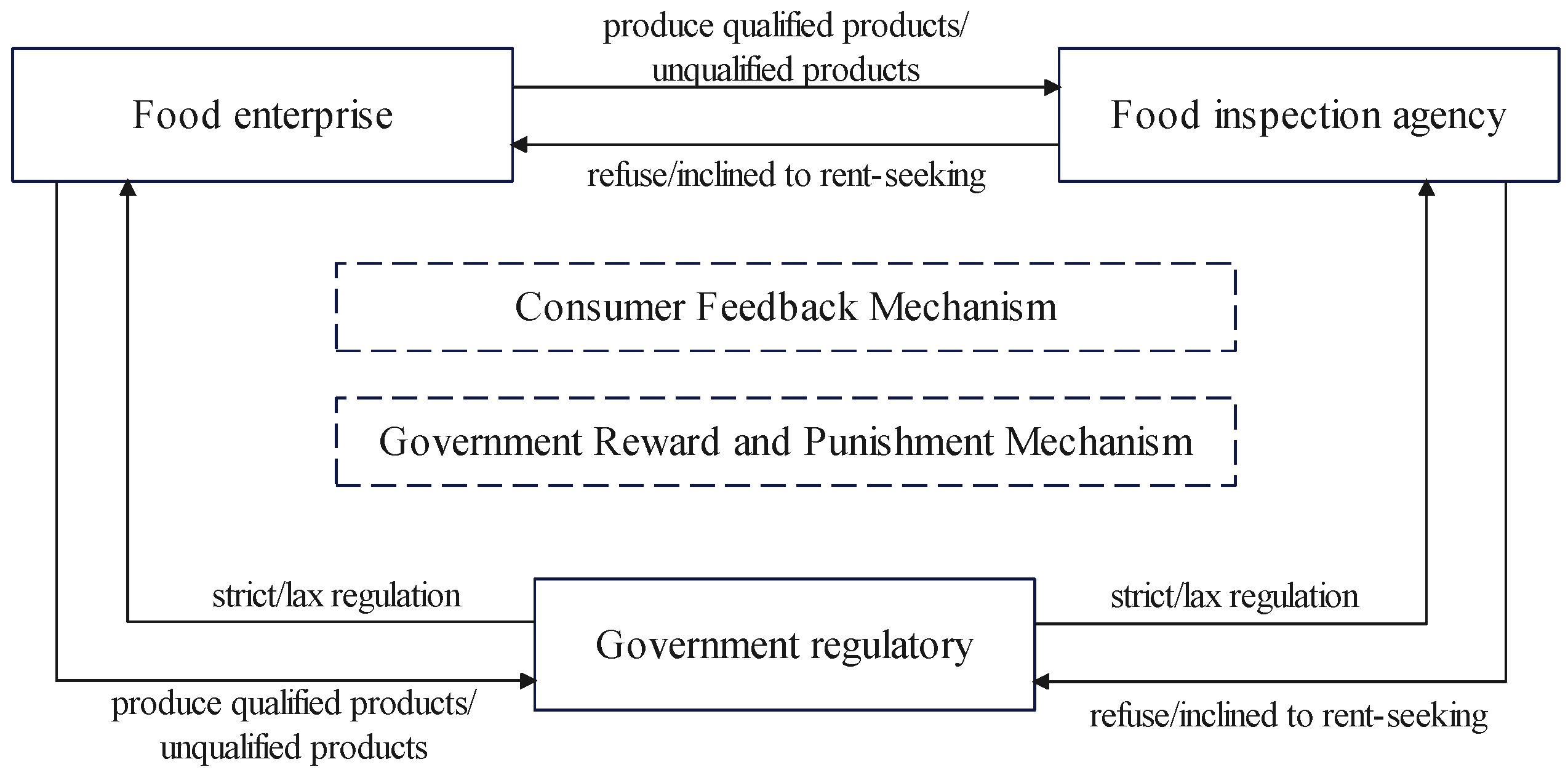







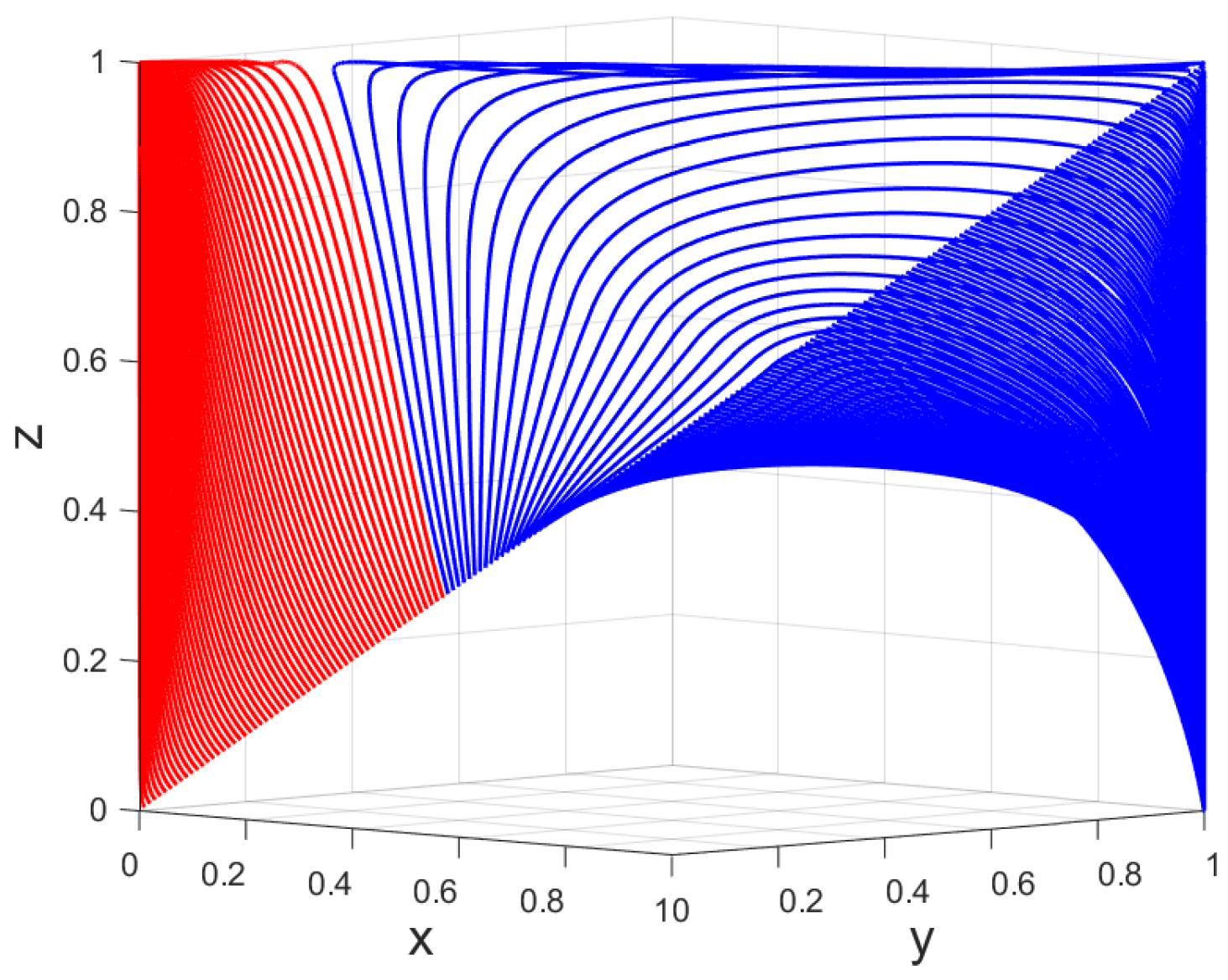



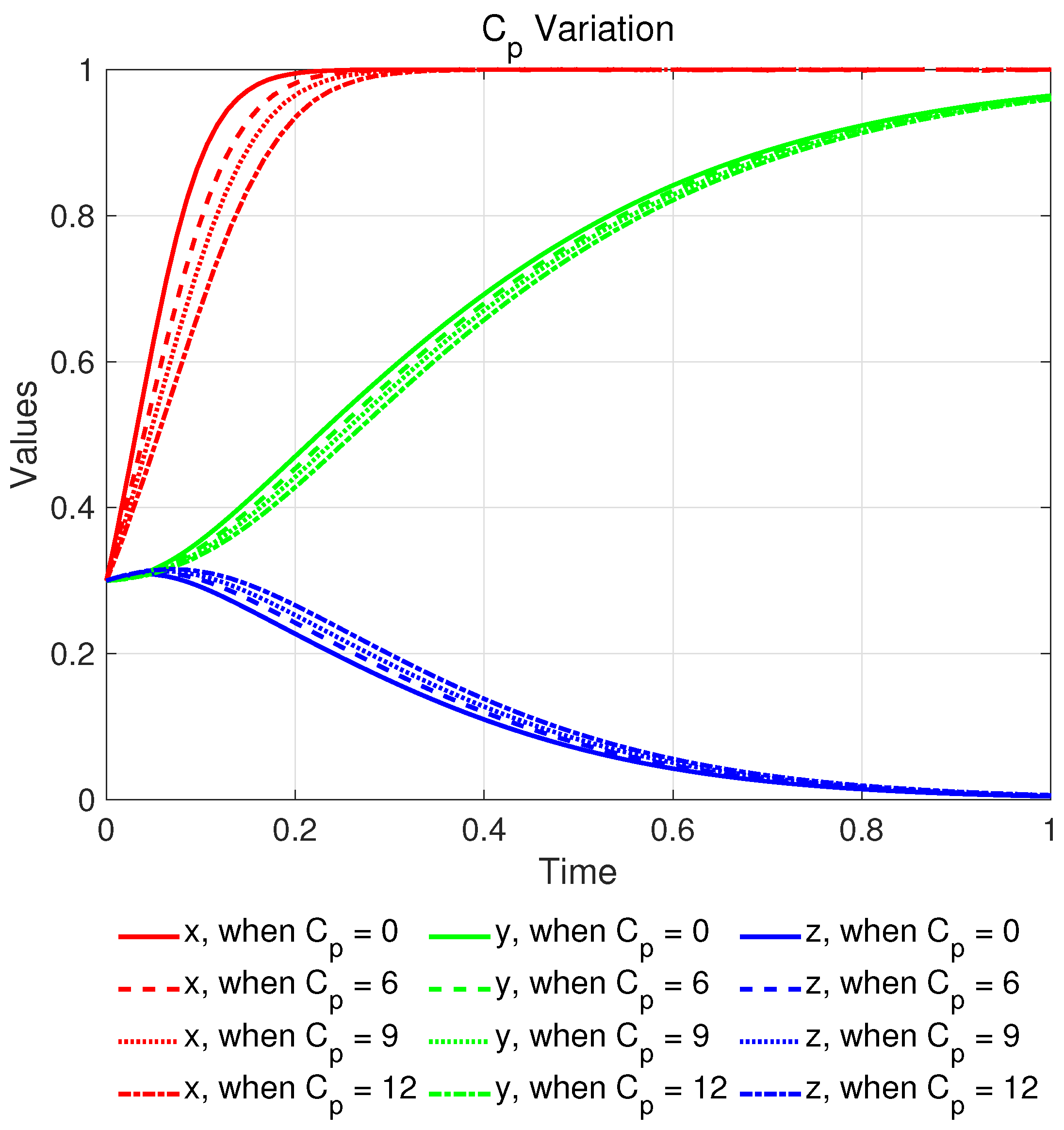

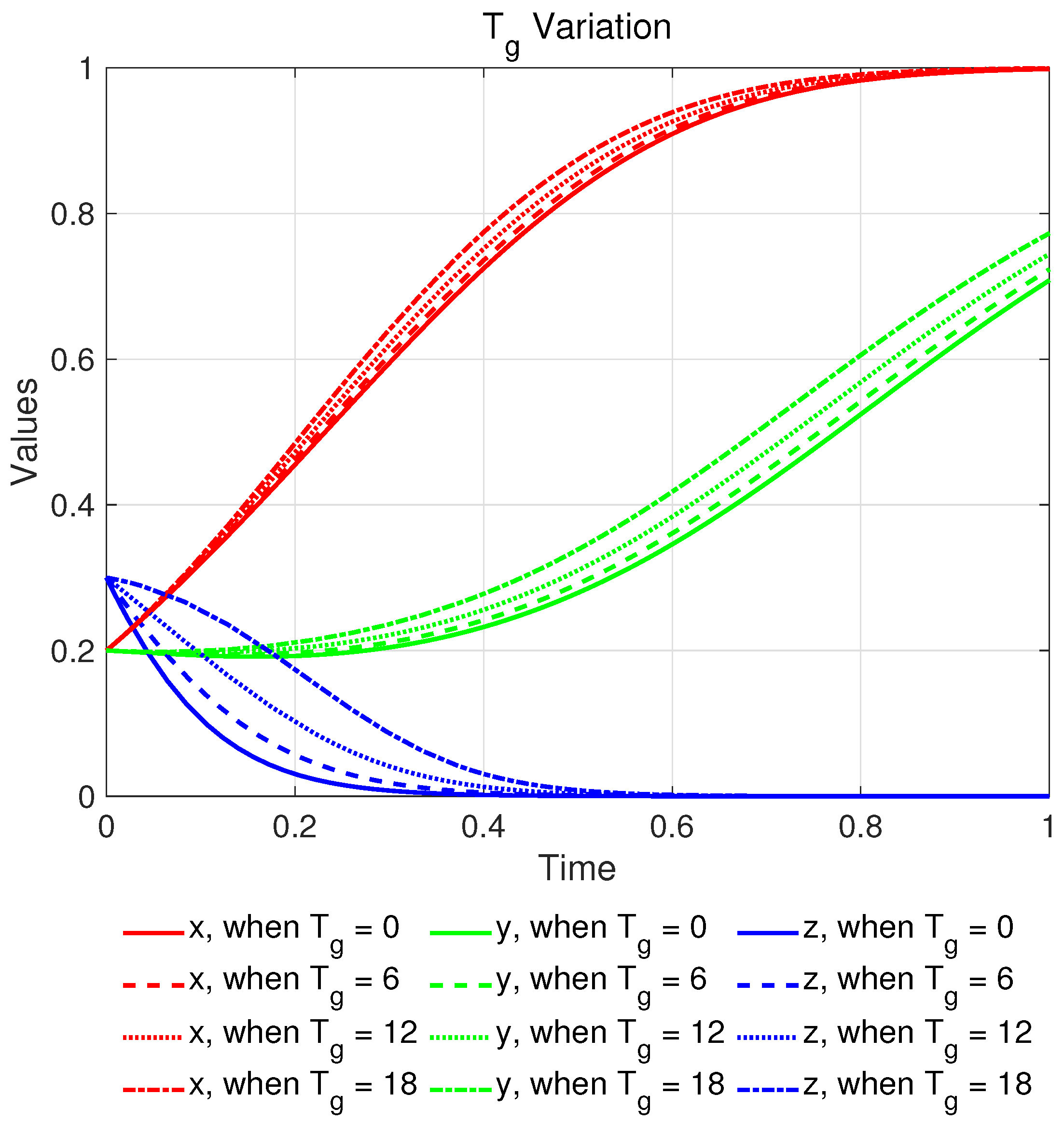
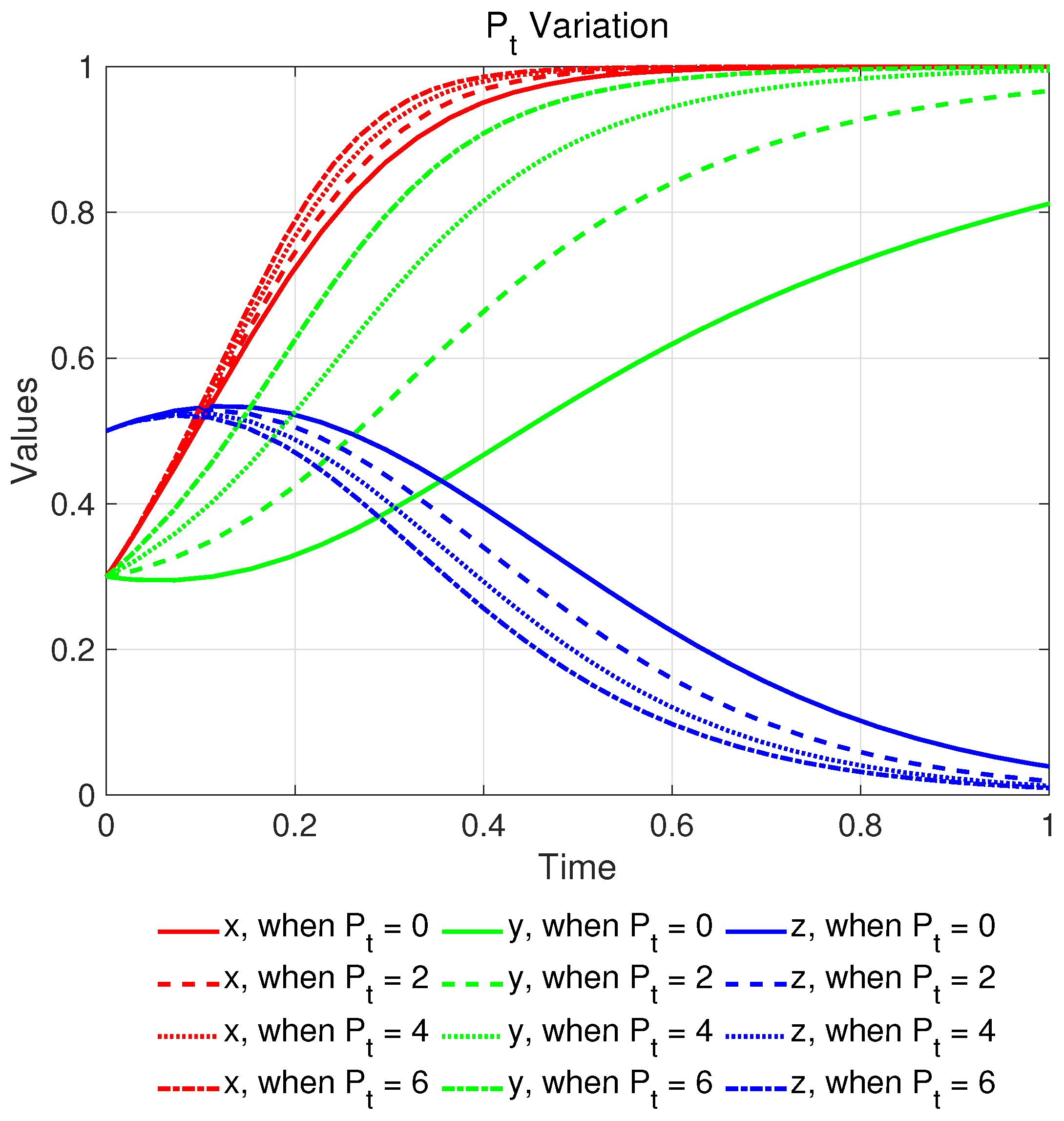
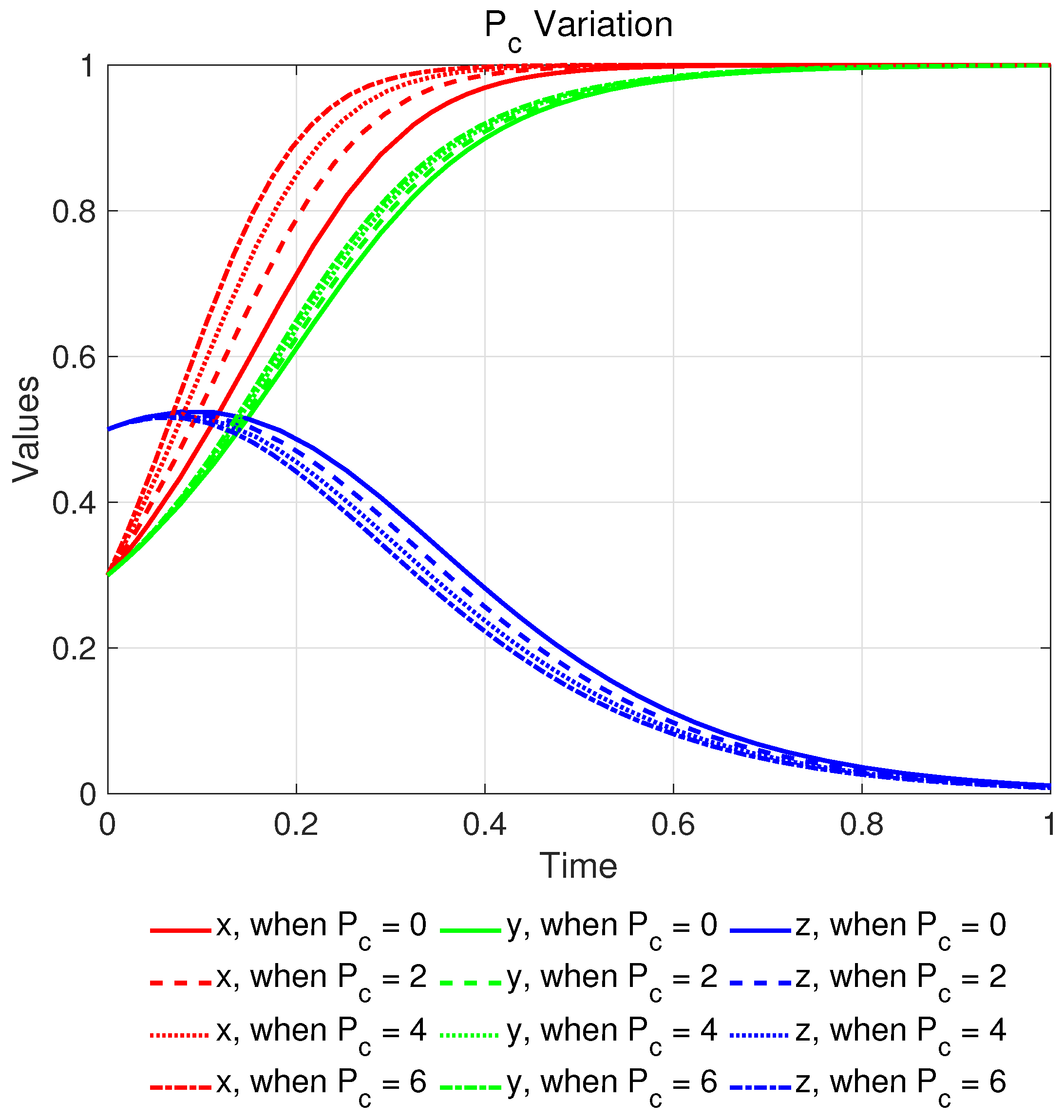
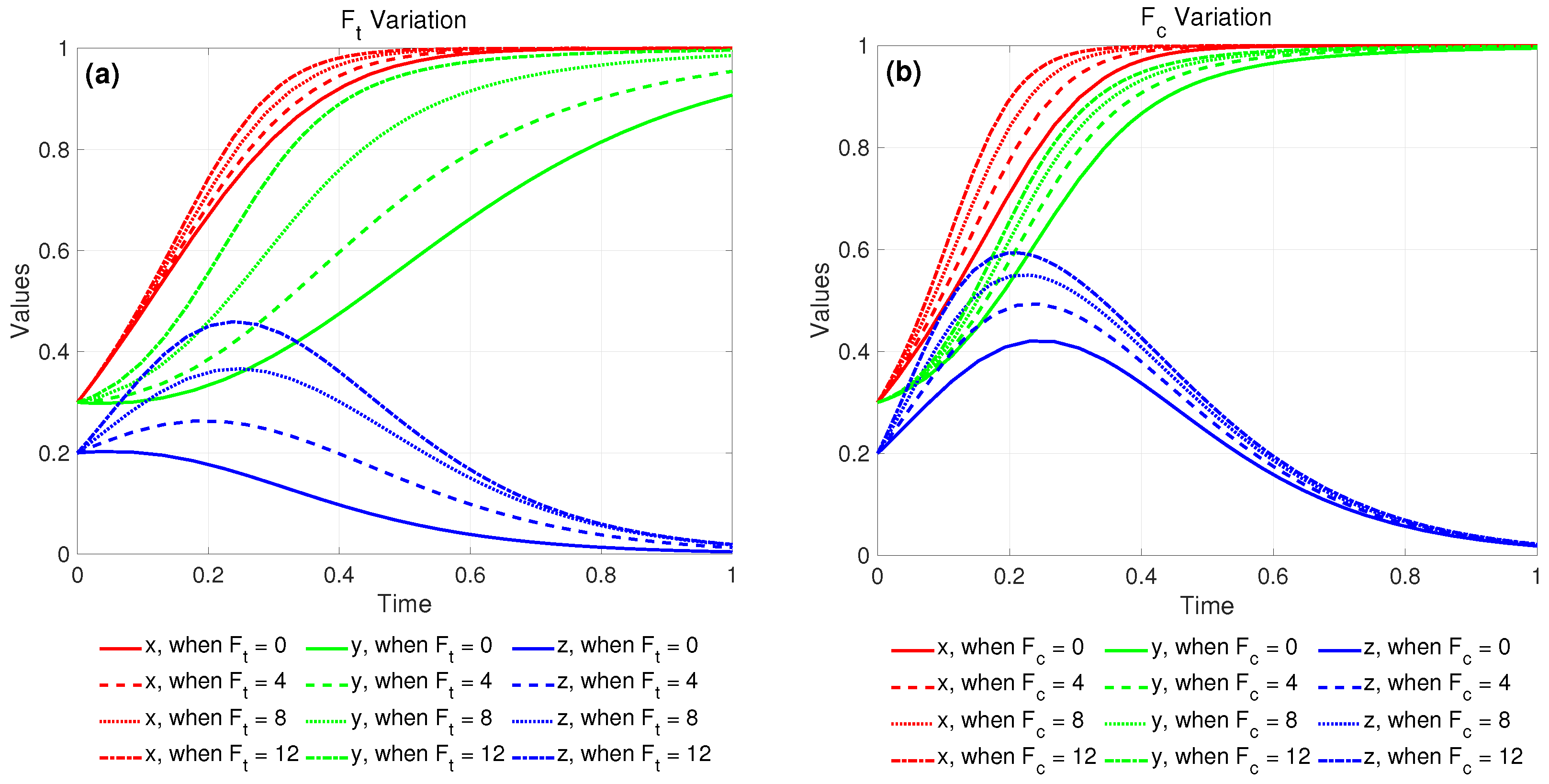
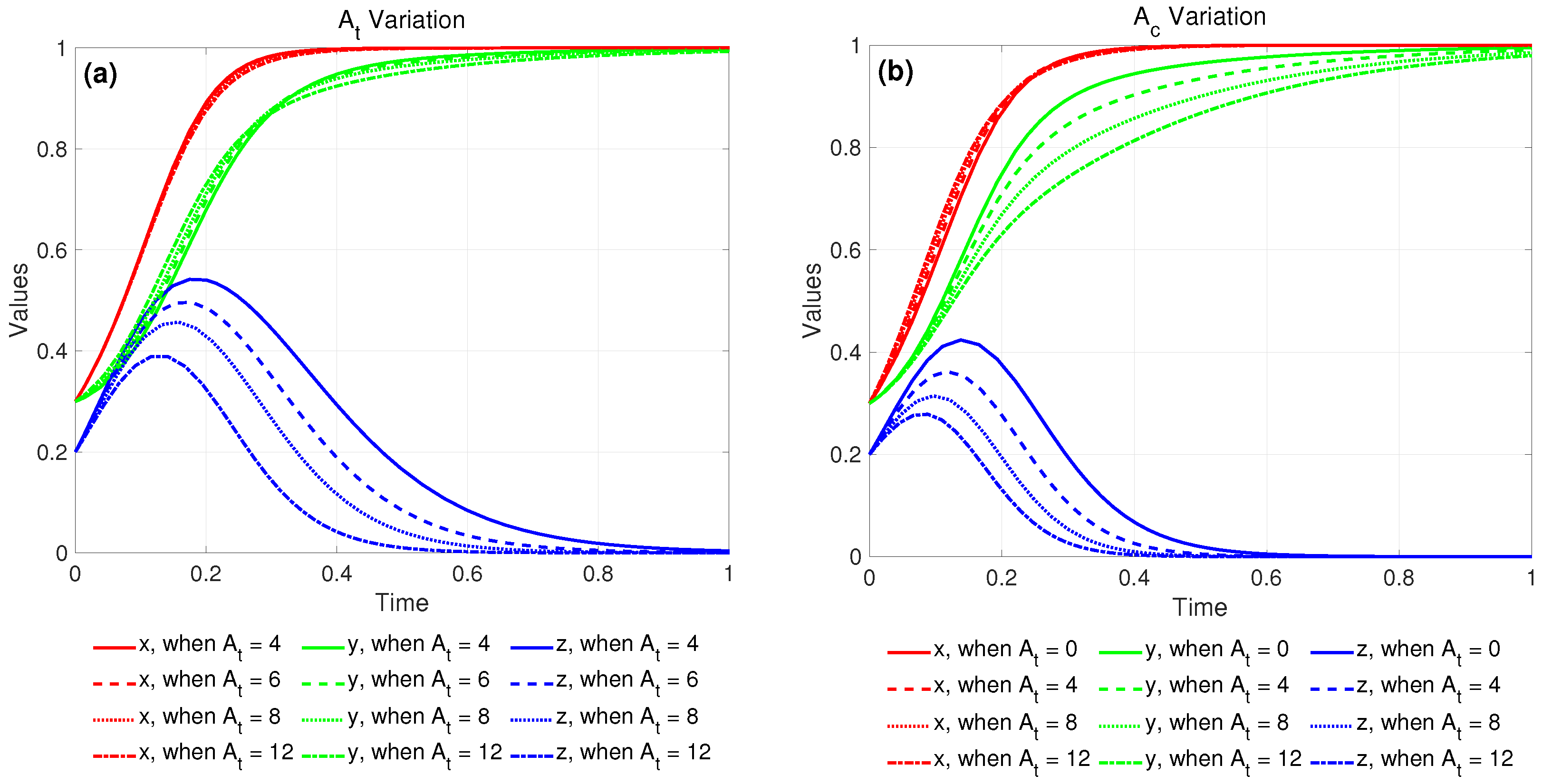
| Food Inspection Agency | Government Regulatory | |||
|---|---|---|---|---|
| Strict Regulation (z) | Lax Regulation (1 − z) | |||
| Food Enterprise | Qualified Products (x) | Refuse Rent-seeking (y) | , , | , , |
| Intend Rent-seeking (1 − y) | , , | , , | ||
| Produce Unqualified Products (1 − x) | Refuse Rent-seeking (y) | , , | , , 0 | |
| Intend Rent-seeking (1 − y) | , , | , , | ||
| Equilibrium | Eigenvalue | Local Stability | Condition |
|---|---|---|---|
| Unstable | - | ||
| , , | ESS | 1 | |
| , | Unstable | - | |
| , , | Unstable | - | |
| , , | ESS | - | |
| , | Unstable | - | |
| , | Unstable | - | |
| Unstable | - | ||
| Unstable | 2 | ||
| Unstable | 3 | ||
| Unstable | 4 | ||
| Uncertain | - |
Disclaimer/Publisher’s Note: The statements, opinions and data contained in all publications are solely those of the individual author(s) and contributor(s) and not of MDPI and/or the editor(s). MDPI and/or the editor(s) disclaim responsibility for any injury to people or property resulting from any ideas, methods, instructions or products referred to in the content. |
© 2024 by the authors. Licensee MDPI, Basel, Switzerland. This article is an open access article distributed under the terms and conditions of the Creative Commons Attribution (CC BY) license (https://creativecommons.org/licenses/by/4.0/).
Share and Cite
Su, T.; Wu, L.; Zhang, J. Evolutionary Game and Simulation Analysis of Food Safety Regulation under Time Delay Effect. Mathematics 2024, 12, 1181. https://doi.org/10.3390/math12081181
Su T, Wu L, Zhang J. Evolutionary Game and Simulation Analysis of Food Safety Regulation under Time Delay Effect. Mathematics. 2024; 12(8):1181. https://doi.org/10.3390/math12081181
Chicago/Turabian StyleSu, Tianjun, Linhai Wu, and Jingxiang Zhang. 2024. "Evolutionary Game and Simulation Analysis of Food Safety Regulation under Time Delay Effect" Mathematics 12, no. 8: 1181. https://doi.org/10.3390/math12081181






